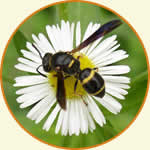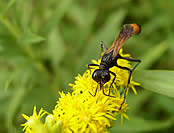USDA Forest Service Celebrating Wildflowers
|
|
|
Wasp PollinationWasps are very important pollinators. Wasps are in the same Order, Hymenoptera, as bees and ants. Most familiar wasps belong to a group called the Aculeata. The word "Aculeata" refers to the defining feature of the group, the modification of their ovipositors into stingers, however not all members of Aculeata sting. In some members, the ovipositor is modified for a different function, such as laying eggs, or was entirely lost. This group is largely predatory or parasitic. Wasps look like bees, but are generally not covered with fuzzy hairs. As a result, they are much less efficient in pollinating flowers, because pollen is less likely to stick to their bodies and to be moved from flower to flower. Energy NeedsWasps, like bees, have very high-energy needs that must be met for their survival. Wasps need key resources such as pollen and nectar from a variety of flowers. The true wasps have stingers that they use to capture insects or spiders for food for their larvae.
Fun FactIn the tropics, minute fig wasps are abundant. Figs are keystone species in many tropical ecosystems. Fig wasps are responsible for pollinating almost 1,000 species of figs. Figs are unusual fruits as the flowers are actually inside the immature fruit. Fig wasps enter through a tiny pore to mate, lay eggs, and pollinate the tiny flowers. |
|
| Ants | Bats | Bees | Beetles | Birds | Butterflies | Flies | Moths | Unusual | Wasps | Wind & Water | |
| NOTE: PDF format links require the Adobe Acrobat Reader to view. | |
| top | Disclaimers | FOIA | Privacy Policy | Quality of Information | Photo Credits & Use |
Location: http://www.fs.fed.us/wildflowers/pollinators/wasps.shtml
Last modified: Tuesday, 20-May-2008 15:56:23 EDT




